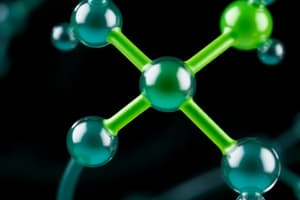Podcast
Questions and Answers
What is the primary criterion for the arrangement of elements in the periodic table?
What is the primary criterion for the arrangement of elements in the periodic table?
- Chemical reactivity
- Increasing atomic mass
- Similar tastes and textures
- Increasing atomic number and properties (correct)
Which of the following describes a characteristic of acids?
Which of the following describes a characteristic of acids?
- Accepts protons and feels slippery
- Contains hydroxide ions and is typically colorless
- Donates protons and tastes sour (correct)
- Taste bitter and turn red litmus paper blue
Which statement is true regarding the second law of thermodynamics?
Which statement is true regarding the second law of thermodynamics?
- Heat can be completely converted into work
- Energy transfer results in an increase of entropy (correct)
- Energy can be created under certain conditions
- Entropy decreases in isolated systems
What best describes a mole in chemistry?
What best describes a mole in chemistry?
What is the primary function of personal protective equipment (PPE) in a laboratory setting?
What is the primary function of personal protective equipment (PPE) in a laboratory setting?
Which branch of chemistry focuses on the study of living organisms?
Which branch of chemistry focuses on the study of living organisms?
What is the primary difference between ionic and covalent bonds?
What is the primary difference between ionic and covalent bonds?
Which of the following describes a physical change?
Which of the following describes a physical change?
What defines the atomic number of an element?
What defines the atomic number of an element?
In which state of matter are the particles closest together and have fixed positions?
In which state of matter are the particles closest together and have fixed positions?
Which type of reaction is characterized by the breakdown of a single compound into two or more simpler substances?
Which type of reaction is characterized by the breakdown of a single compound into two or more simpler substances?
What is the mass number of an atom if it contains 6 protons and 8 neutrons?
What is the mass number of an atom if it contains 6 protons and 8 neutrons?
Which of these characteristics is considered a chemical property of a substance?
Which of these characteristics is considered a chemical property of a substance?
Flashcards are hidden until you start studying
Study Notes
Basic Concepts of Chemistry
- Definition: Chemistry is the study of matter, its properties, composition, structure, and the changes it undergoes during chemical reactions.
- Branches of Chemistry:
- Organic Chemistry: Study of carbon-containing compounds.
- Inorganic Chemistry: Study of inorganic compounds, typically those without carbon-hydrogen bonds.
- Physical Chemistry: Study of the physical properties and behavior of chemical systems.
- Analytical Chemistry: Techniques and methods used to analyze substances.
- Biochemistry: Study of chemical processes within living organisms.
Matter and Its Properties
- Matter: Anything that has mass and occupies space.
- States of Matter:
- Solid: Definite shape and volume.
- Liquid: Definite volume but takes the shape of its container.
- Gas: Neither definite shape nor volume.
- Properties of Matter:
- Physical Properties: Characteristics that can be observed without changing the substance (e.g., color, melting point).
- Chemical Properties: Characteristics that determine how a substance behaves in a chemical reaction (e.g., reactivity, flammability).
Atomic Structure
- Atom: Basic unit of matter, composed of protons, neutrons, and electrons.
- Subatomic Particles:
- Protons: Positively charged particles in the nucleus.
- Neutrons: Neutral particles in the nucleus.
- Electrons: Negatively charged particles surrounding the nucleus.
- Atomic Number: Number of protons in an atom, defines the element.
- Mass Number: Total number of protons and neutrons in the nucleus.
Chemical Bonds
- Ionic Bonds: Formed between metals and nonmetals through the transfer of electrons.
- Covalent Bonds: Formed when two nonmetals share electrons.
- Metallic Bonds: Bonds found in metals where electrons are shared in a "sea" of electrons.
Chemical Reactions
- Definition: Process in which substances (reactants) transform into different substances (products).
- Types of Reactions:
- Synthesis: Two or more substances combine to form one product.
- Decomposition: A single compound breaks down into two or more simpler substances.
- Single Replacement: One element replaces another in a compound.
- Double Replacement: Exchange of ions between two compounds.
- Combustion: Reaction with oxygen, producing energy, carbon dioxide, and water.
The Periodic Table
- Arrangement: Elements organized by increasing atomic number and properties.
- Groups: Vertical columns with similar chemical behaviors (e.g., alkali metals, noble gases).
- Periods: Horizontal rows that indicate the number of electron shells.
Acids and Bases
- Acids: Substances that donate protons (H⁺ ions). Taste sour, turn blue litmus paper red.
- Bases: Substances that accept protons or donate hydroxide ions (OH⁻). Taste bitter, turn red litmus paper blue.
- pH Scale: Measures acidity or basicity (0-14 scale; 7 is neutral).
Stoichiometry
- Definition: Branch of chemistry dealing with the calculation of reactants and products in chemical reactions.
- Mole Concept: A mole is 6.022 x 10²³ particles (atoms, molecules, etc.).
- Balanced Equations: Ensure that the number of each type of atom is the same on both sides of the reaction.
Thermodynamics
- First Law: Energy cannot be created or destroyed, only transformed.
- Second Law: In any energy transfer, entropy (disorder) increases.
Key Chemical Laws
- Law of Conservation of Mass: Mass is neither created nor destroyed in a chemical reaction.
- Law of Definite Proportions: A chemical compound always contains its component elements in fixed ratio by mass.
Laboratory Safety
- Personal Protective Equipment (PPE): Must wear lab coats, gloves, and goggles.
- Safety Procedures: Know emergency exits, safety showers, and eye wash stations.
Basic Concepts of Chemistry
- Chemistry studies matter, its properties, composition, structure, and changes during reactions.
- Organic chemistry focuses on carbon-containing compounds, while inorganic chemistry studies compounds lacking carbon-hydrogen bonds.
- Physical chemistry examines the physical properties and behaviors of chemical systems.
- Analytical chemistry involves techniques for substance analysis.
- Biochemistry explores chemical processes in living organisms.
Matter and Its Properties
- Matter is defined as anything with mass that occupies space.
- States of matter include:
- Solid: Has a definite shape and volume.
- Liquid: Has a definite volume but adapts to the shape of its container.
- Gas: Lacks a definite shape and volume.
- Physical properties are observable without altering the substance, such as color and melting point.
- Chemical properties indicate a substance's behavior in reactions, like reactivity and flammability.
Atomic Structure
- Atoms are the basic units of matter, consisting of protons, neutrons, and electrons.
- Subatomic particles include:
- Protons: Positively charged and found in the nucleus.
- Neutrons: Neutral particles also in the nucleus.
- Electrons: Negatively charged and located outside the nucleus.
- The atomic number reflects the number of protons in an atom, determining the element's identity.
- Mass number is the sum of protons and neutrons in the nucleus.
Chemical Bonds
- Ionic bonds occur between metals and nonmetals when electrons are transferred.
- Covalent bonds form through the sharing of electrons between two nonmetals.
- Metallic bonds exist in metals where electrons are shared in a delocalized manner.
Chemical Reactions
- A chemical reaction transforms reactants into products.
- Types of reactions include:
- Synthesis: Multiple substances combine into one product.
- Decomposition: A compound breaks into simpler components.
- Single Replacement: An element replaces another in a compound.
- Double Replacement: Ions are exchanged between two compounds.
- Combustion: A reaction with oxygen, generating energy, carbon dioxide, and water.
The Periodic Table
- Elements are organized by increasing atomic number and similar properties.
- Groups are vertical columns representing elements with similar behaviors, e.g., alkali metals and noble gases.
- Periods are horizontal rows indicating the number of electron shells.
Acids and Bases
- Acids are proton (H⁺ ion) donors, taste sour, and turn blue litmus paper red.
- Bases accept protons or donate hydroxide ions (OH⁻), taste bitter, and turn red litmus paper blue.
- The pH scale measures acidity or basicity, ranging from 0 to 14 with 7 being neutral.
Stoichiometry
- Stoichiometry involves calculating reactants and products in chemical reactions.
- A mole represents 6.022 x 10²³ particles, such as atoms or molecules.
- Balanced equations maintain an equal number of each type of atom on both sides of the reaction.
Thermodynamics
- The first law states that energy cannot be created or destroyed, only transformed.
- The second law asserts that entropy increases in energy transfers.
Key Chemical Laws
- The law of conservation of mass indicates mass is unchanged in chemical reactions.
- The law of definite proportions states that chemical compounds have fixed ratios of elements by mass.
Laboratory Safety
- Personal protective equipment (PPE) includes lab coats, gloves, and goggles for safety.
- Familiarize yourself with emergency exits, safety showers, and eye wash stations.
Studying That Suits You
Use AI to generate personalized quizzes and flashcards to suit your learning preferences.




